Griffiths D. Head First Statistics
Подождите немного. Документ загружается.

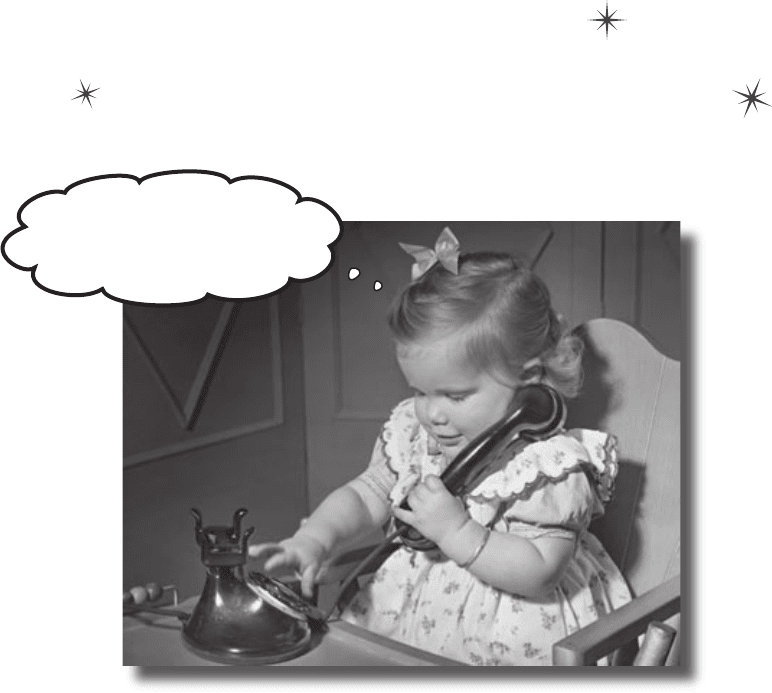
this is a new chapter 241
permutations and combinations
6
Making Arrangements
Sometimes, order is important.
Counting all the possible ways in which you can order things is time
consuming, but the trouble is, this sort of information is crucial for
calculating some probabilities. In this chapter, we’ll show you a quick way
of deriving this sort of information without you having to figure out what all
of the possible outcomes are. Come with us and we’ll show you how to
count the possibilities.
If I try every permutation,
sooner or later I’ll get through
to Tom’s Tattoo Parlor.
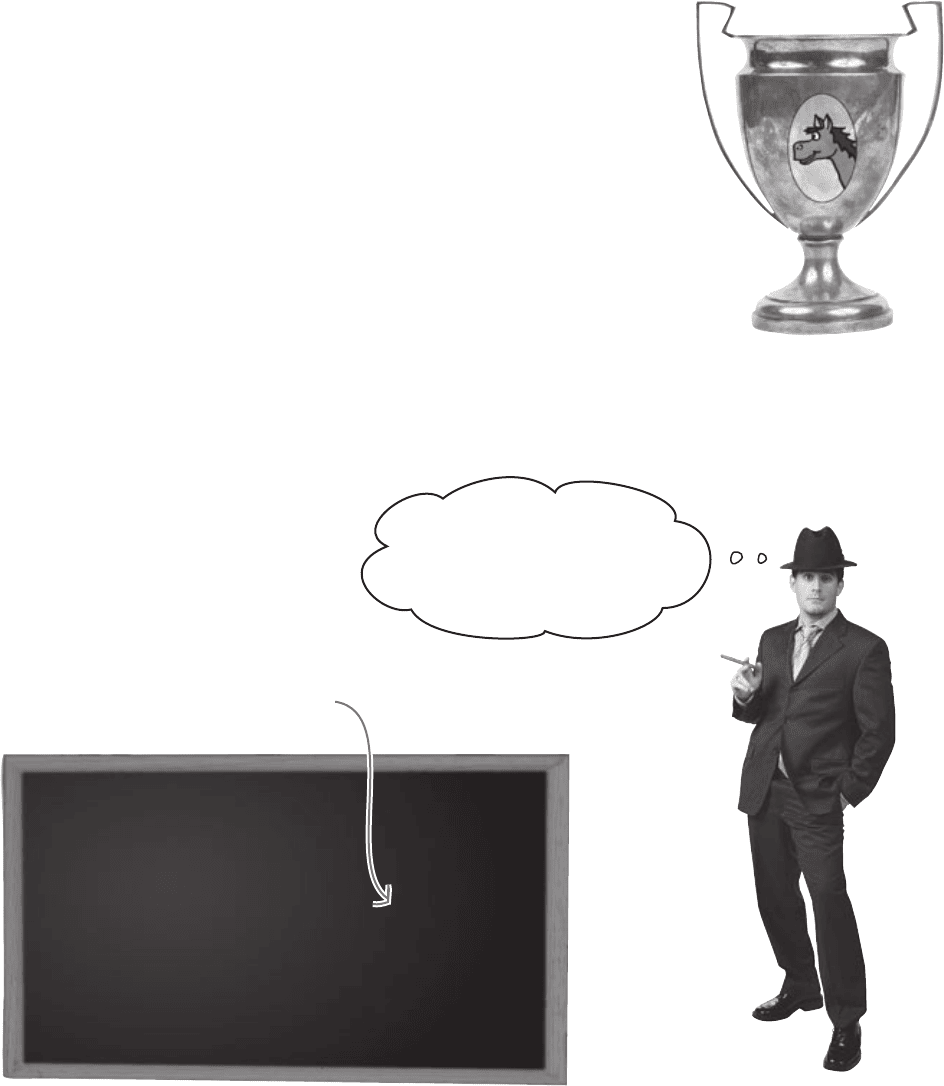
242 Chapter 6
The Statsville Derby
One of the biggest sporting events in Statsville is the Statsville Derby.
Horses and jockeys travel from far and wide to see which horse can
complete the track in the shortest time, and you can place bets on the
outcome of each race. There’s a lot of money to be made if you can
predict the top three finishers in each race.
The opening set of races is for rookies, horses that have never
competed in a race before. This time, no statistics are available for
previous races to help you anticipate how well each horse will do.
This means you have to assume that each horse has an equal chance
of winning, and it all comes down to simple probability.
The first race of the day, the three-horse race, is just about to begin,
and the Derby is taking bets. You have $500 of winnings from Fat
Dan’s Casino to spend at the Derby. If you can correctly predict the
order in which the three horses finish, the payout is 7:1, which means
you’ll win 7 times your bet, or $3,500.
Should we take this bet? Let’s work out some probabilities and find
out.
Want to join in with the fun?
If you know a thing or two
about probability, you could do
very well indeed.
Statsville Derby Races: Payouts:
Three-Horse 7:1
Novelty 15:1
Twenty-Horse 1,500:1
A 15:1 payout means that if
you win, you’ll earn 15 times
the amount you bet!
at the racetrack
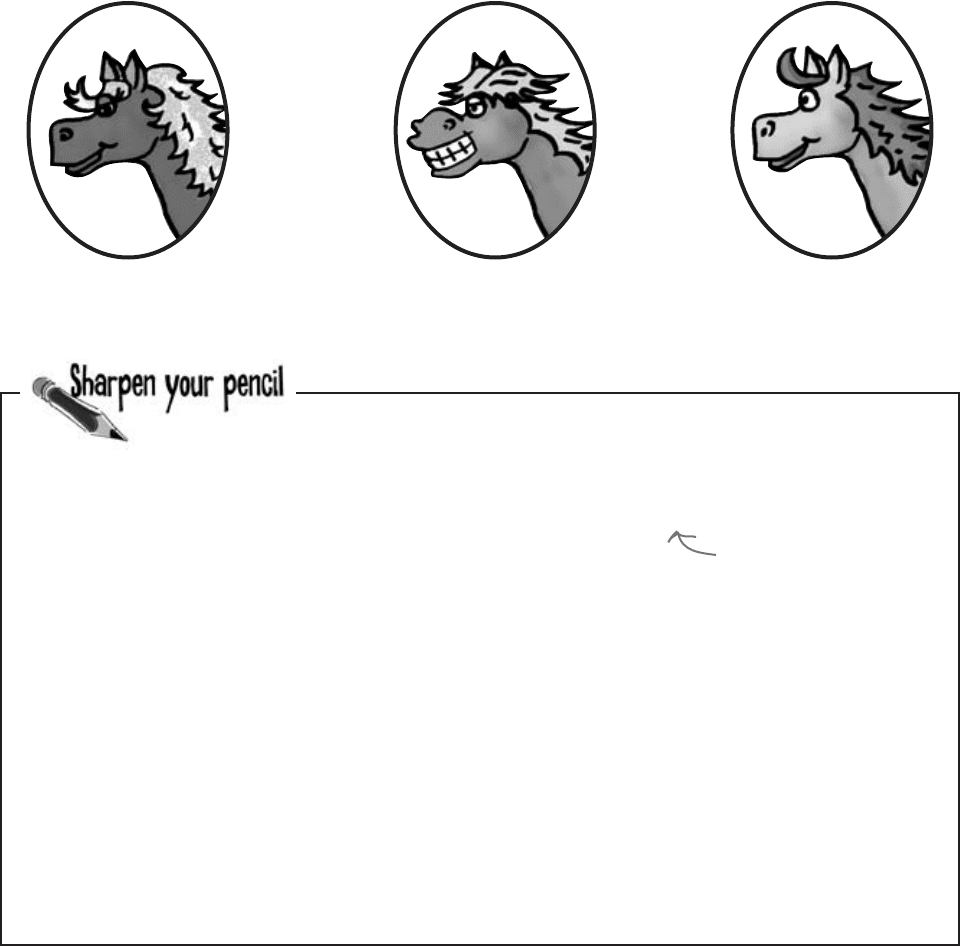
you are here 4 243
permutations and combinations
It’s a three-horse race
The first race is a very simple one between three horses, and in order
to make the most amount of money, you need to predict the exact
order in which horses finish the race. Here are the contenders.
How many different ways are there in which the horses can finish
the race? (Assume there are no ties and that every horse finishes.)
What’s the probability of winning a bet on the correct finishing
order?
Calculate your expected winnings for this bet.
Cheeky Sherbet Ruby Toupee
Frisky Funboy
Hint: Find the probability
distribution for this event.
Then use this to calculate
the expectation.
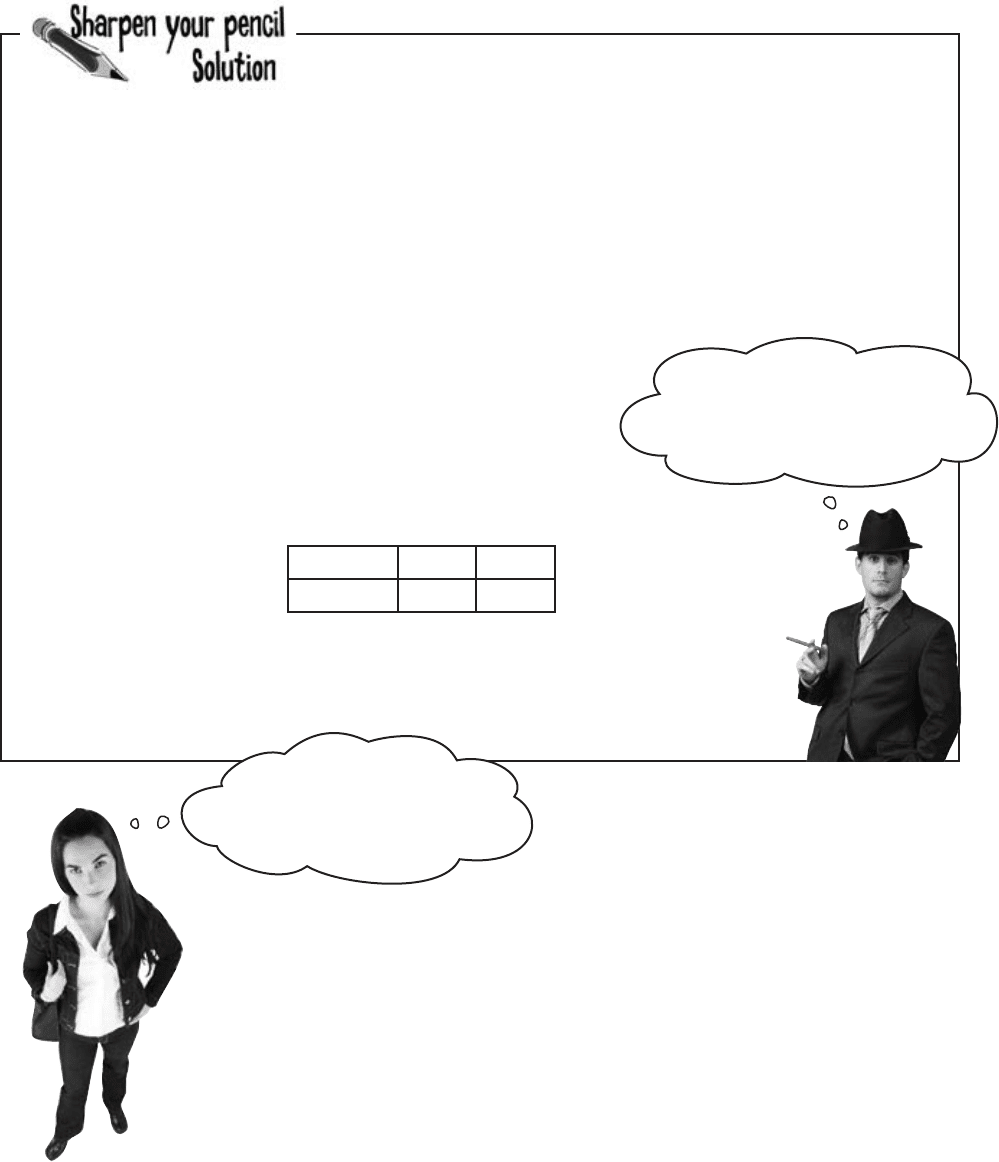
244 Chapter 6
How many different ways are there in which the horses can finish
the race? (Assume there are no ties and that every horse finishes.)
What’s the probability of winning a bet on the correct finishing
order?
Calculate your expected winnings for this bet.
There are 6 different ways in which the race can be finished:
Cheeky Sherbet, Ruby Toupee, Frisky Funboy
Cheeky Sherbet, Frisky Funboy, Ruby Toupee
Ruby Toupee, Cheeky Sherbet, Frisky Funboy
Ruby Toupee, Frisky Funboy, Cheeky Sherbet
Frisky Funboy, Cheeky Sherbet, Ruby Toupee
Frisky Funboy, Ruby Toupee, Cheeky Sherbet
The probability of getting the order right is therefore 1/6.
Here’s the probability distribution for amount of money you can expect
to win if you bet $500 with odds of 7:1
A three-horse race? How
likely is that? Most races will
have far more horses taking part.
Exactly, most races will have more than three horses.
So what we need is some quick way of figuring out how many finishing orders
there are for each race, one that works irrespective of how many horses are
racing.
Working out the number of ways in which three horses can finish a race is
straightforward; there are only 6 possibilities. The trouble is, the more horses
there are taking part in the race, the harder and more time consuming it is to
work out every possible finishing order.
Let’s take a closer look at the different ways of ordering the three horses we have
for the race and see if we can spot a pattern. We can do this by looking at each
position, one by one.
x -500 3,500
P(X = x) 0.833 0.167
Three-horse race:
E(X) = -500x0.833 + 3,500x0.167
= 168
We can expect to win $168 each time this race is won.
Yes, you can expect to win
$168 on this bet, but the house
is still going to win 5/6 times
you play. Do you feel lucky?
sharpen solution
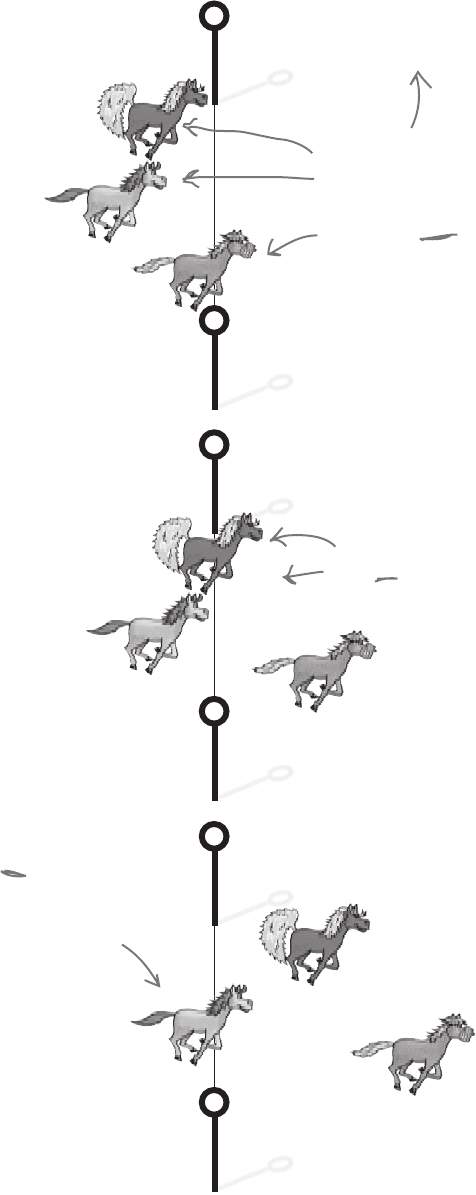
you are here 4 245
permutations and combinations
Let’s start by looking at the first position of the race.
One of the horses has to win the race, and this
can be any one of the three horses taking part.
This means that there are three ways of filling the
number one position.
3 ways
How many ways can they cross the finish line?
So what about the second position in the race?
If one of the horses has finished the race, this
means there are two horses left. Either of these can
come second in the race. This means that there are
two ways of filling the number two position, no
matter which horse came first.
Only one horse can
cross the finish line
first, but it can be
any of the three
horses.
Once two horses have finished the race, there’s
only one position left for the final horse—third
place.
One horse has
already finished the
race, so there are
only two horses that
can finish second.
So how does this help us calculate all the possible
finishing orders?
2 ways
1 way
Only one horse hasn’t
finished the race, so
there’s only one position
left for him: last.

246 Chapter 6
So what if there are n horses?
You’ve seen that there are 3
×
2
×
1 ways of ordering 3 horses. You can
generalize this for any number n. If you want to work out the number
of ways there are of ordering n separate objects, you can get the right
result by calculating:
n! = n
×
(n - 1)
×
(n - 2)
×
...
×
3
×
2
×
1
This means that if you have to work out the number of ways in which
you can order n separate objects, you can come up with a precise figure
without having to figure out every possible arrangement.
This type of calculation is called the factorial of a number. In math
notation, factorials are represented as an exclamation point. For
example, the factorial of 3 is written as 3!, and the factorial of n is n!.
You pronounce it “n factorial.”
So when we write n!, this is just a shorthand way of saying “take all
the numbers from n down to 1, and multiply them together.” In other
words, perform the following calculation:
Calculate the number of arrangements
We just saw that there were 3 ways of filling the first position, and for
each of these, there are 2 ways of filling the second position. And no
matter how those first two slots are filled, there’s only one way of filling
the last position. In other words, the number of ways in which we can fill
all three positions is:
3
×
2
×
1 = 6
This means that we can tell there are 6 different ways of ordering the
three horses, without us having to figure out each of the arrangements.
3 ways of filling the
1st position
2 ways of filling the 2nd position
6 ways of filling all 3 positions
n
×
(n - 1)
×
(n - 2)
×
...
×
3
×
2
×
1
The advantage of n! is that a lot of calculators have this as an available
function. If, for example, you want to find the number of arrangements
of 4 separate objects, all you have to do is calculate 4!, giving you
4
×
3
×
2
×
1 = 24 separate arrangements.
1 way of filling
the 3rd position
making arrangements
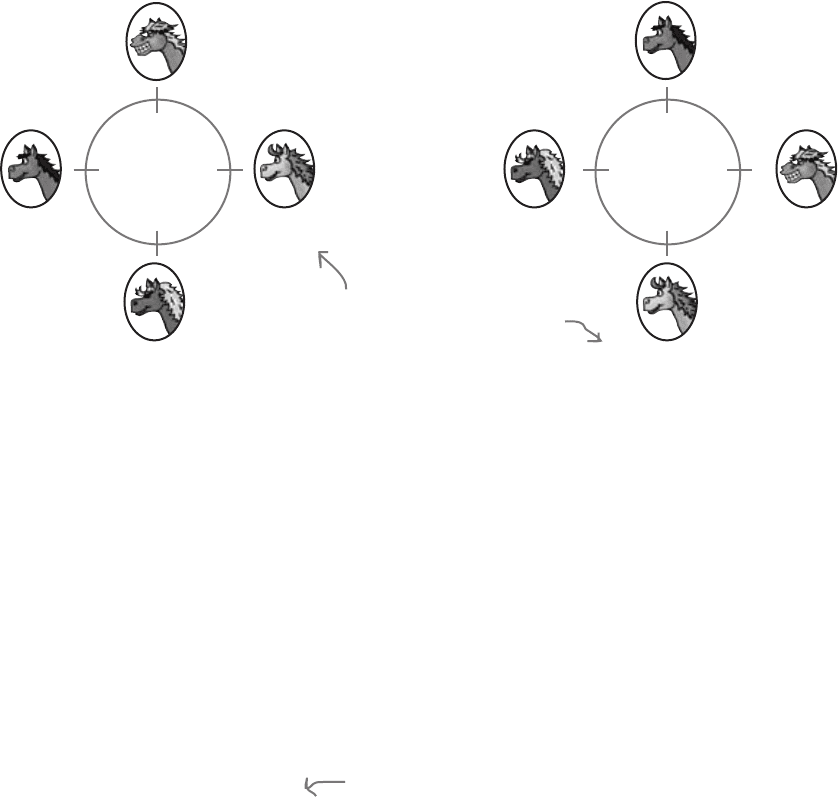
you are here 4 247
permutations and combinations
Going round in circles
There’s one exception to this rule, and that’s if you’re arranging
objects in a circle.
Here’s an example. Imagine you want to stand four horses in a circle,
and you want to find the number of possible ways in which you can
order them. Now, let’s focus on arrangements where Frisky Funboy
has Ruby Toupee on his immediate right, and Cheeky Sherbet on his
immediate left. Here are two of the four possible arrangements of this.
The key here is to fix the position of one of the horses, say Frisky Funboy.
With Frisky Funboy standing in a fixed position, you can count the
number of ways in which the remaining 3 horses can be ordered, and this
will give you the right result without any duplicates.
In general, if you have n objects you need to arrange in a circle, the
number of possible arrangements is given by
(n - 1)!
The number of ways of arranging n
objects in a circle
At first glance, these two arrangements look different, but they’re actually
the same. The horses are in exactly the same positions relative to each
other, the only difference is that in the second arrangement, the horses
have walked a short distance round the circle. This means that some of
the ways in which you can order the horses are actually the same.
So how do we solve this sort of problem?
For both of these, Frisky Funboy
has Ruby Toupee on his right, and
Cheeky Sherbet on his left
Cheeky Sherbet
Ruby Toupee
Frisky FunboyOther
Other
Ruby Toupee
Frisky Funboy
Cheeky Sherbet
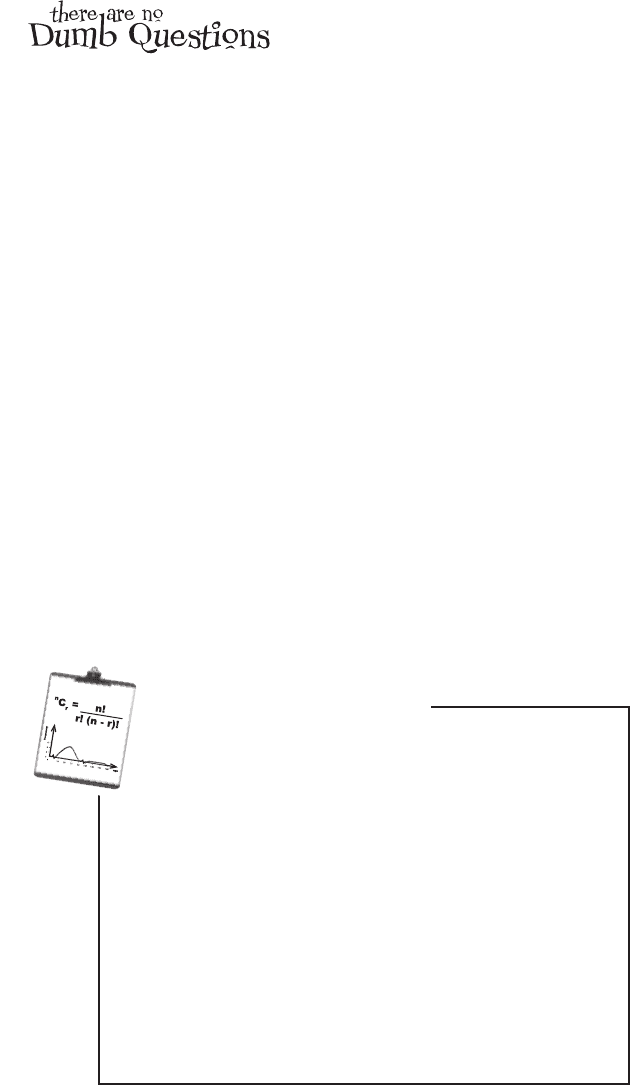
248 Chapter 6
Q:
How do I pronounce n!?
A:
You pronounce it as “n factorial.” The
! symbol is used to indicate a mathematical
operation, and not to indicate any sort of
exclamation.
Q:
Are factorials just used when
you’re arranging objects?
A: Not at all. Factorials also come into
play in other branches of mathematics,
like calculus. In general, they’re a useful
math shorthand, and you’ll see the factorial
symbol whenever you’re faced with this sort
of multiplication task.
All the factorial symbol really means is
“take all the numbers from n down to 1 and
multiply them together.”
Q:
What if I have a value 0? How do I
find 0!?
A: 0! is actually 1. This may seem like a
strange result, but it’s a bit like saying there’s
only one way to arrange 0 objects.
Q:
What about if you want to find the
factorial of a negative number? Or one
that’s not an integer?
A: Factorials only work with positive
integers, so you can’t find the factorial of a
negative number, or one that’s not an integer.
One way of looking at this is that it doesn’t
make sense to arrange bits of objects. Each
thing you’re arranging is classed as a whole
object. Equally, you can’t have a negative
number of objects.
Q:
Can the result of a factorial ever be
an odd number?
A: There are only two occasions where
this can be true, when n is 0 or when n is 1.
In both these cases, n! = 1.
For all other values of n, n! is even. This is
because if n is greater than or equal to 2,
the calculation must include the number 2.
Any integer multiplied by 2 is even, so this
means that n! is even if n is greater than or
equal to 2.
Q:
Calculating factorials for large
numbers seems like a pain. If I want to
find 10!, I have to multiply 10 numbers
(10
×
9
×
8
×
7
×
6
×
5
×
4
×
3
×
2
×
1), and the result
gets really big. Is there an easier way.
A: Yes, many scientific and graphing
calculators have a factorial key (typically
labeled n!) that will perform this calculation
for you.
Q:
If I’m arranging n objects in a
circle, there are (n - 1)! arrangements.
What if clockwise and counterclockwise
arrangements are considered to be the
same?
A: In this case, the number of
arrangements is (n - 1)!/2. Calculating
(n - 1)! gives you twice the number of
arrangements you actually need as it gives
you both clockwise and counterclockwise
arrangements. Dividing by 2 gives you the
right answer.
Q:
What if I’m arranging objects in a
circle and absolute position matters?
A: In this case the number of
arrangements is given by n!. In that situation,
it’s exactly the same as arranging n objects.
Formulas for arrangements
If you want to find the number of possible
arrangements of n objects, use n! where
n! = n x (n-1) x ... x 3 x 2 x 1
In other words, multiply together all the numbers
from n down to 1.
If you are arranging n objects in a circle, then
there are (n - 1)! possible arrangements.
Vital StatisticsVital Statistics
no dumb questions
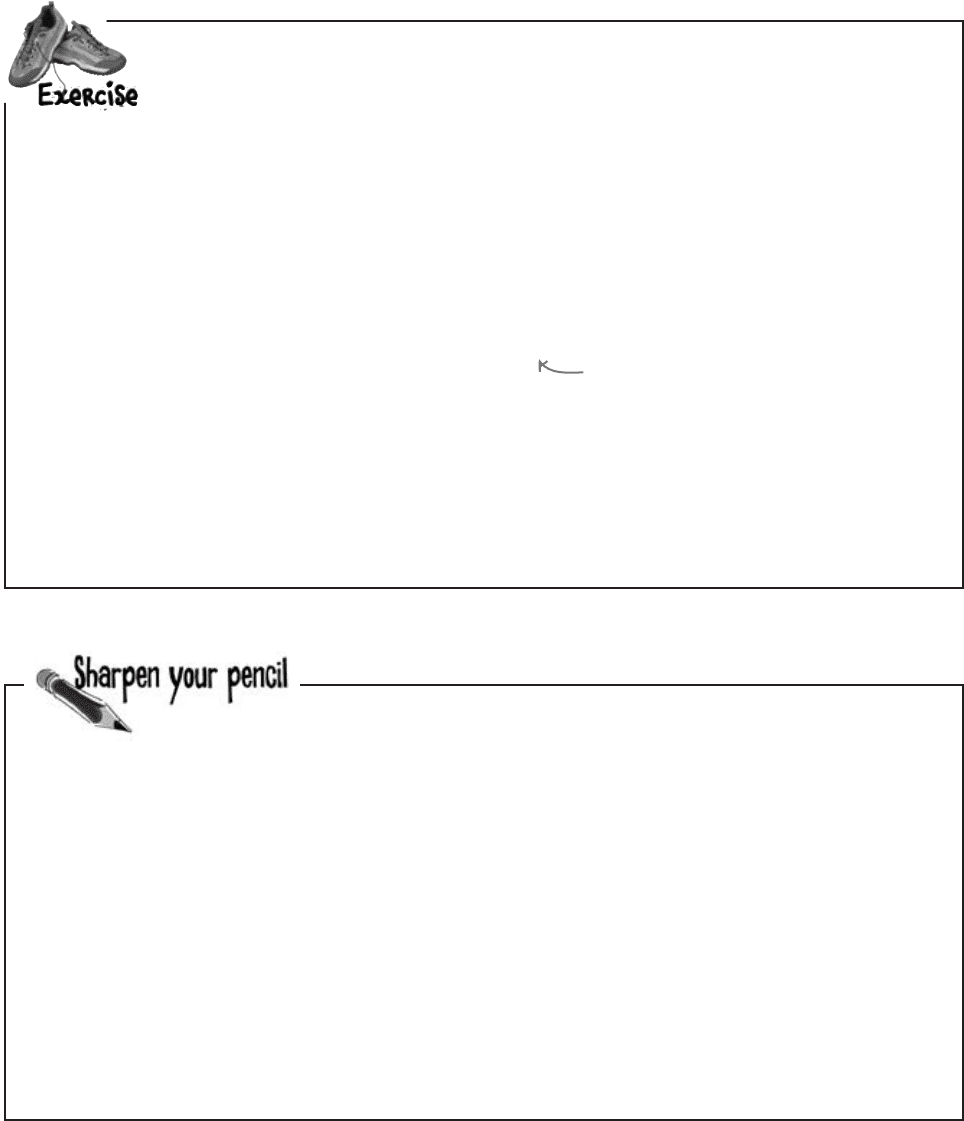
you are here 4 249
permutations and combinations
Paula wants to telephone the Statsville Health Club, but she has a very poor memory. She
knows that the telephone number contains the numbers 1,2,3,4,5,6 and 7, but she can’t
remember the order. What’s the probability of getting the right number at random?
Paula has just been reminded that the first three numbers is some arrangement of the
numbers 1, 2 and 3, and the last four numbers is some arrangement of the numbers 4, 5, 6,
and 7. She can’t remember the order of each set of numbers though. What’s the probability
of getting the right telephone number now?
The Statsville Derby is organizing a parade for the end of the season.
10 horses are taking part, and they will parade round the race track
in a circle. The exact horse order will be chosen at random, and if you
guess the horse order correctly, you win a prize.
What’s the probability that if you make a guess on the exact horse
order, you’ll win the prize?
Hint: This time you need
to arrange two groups of
numbers.
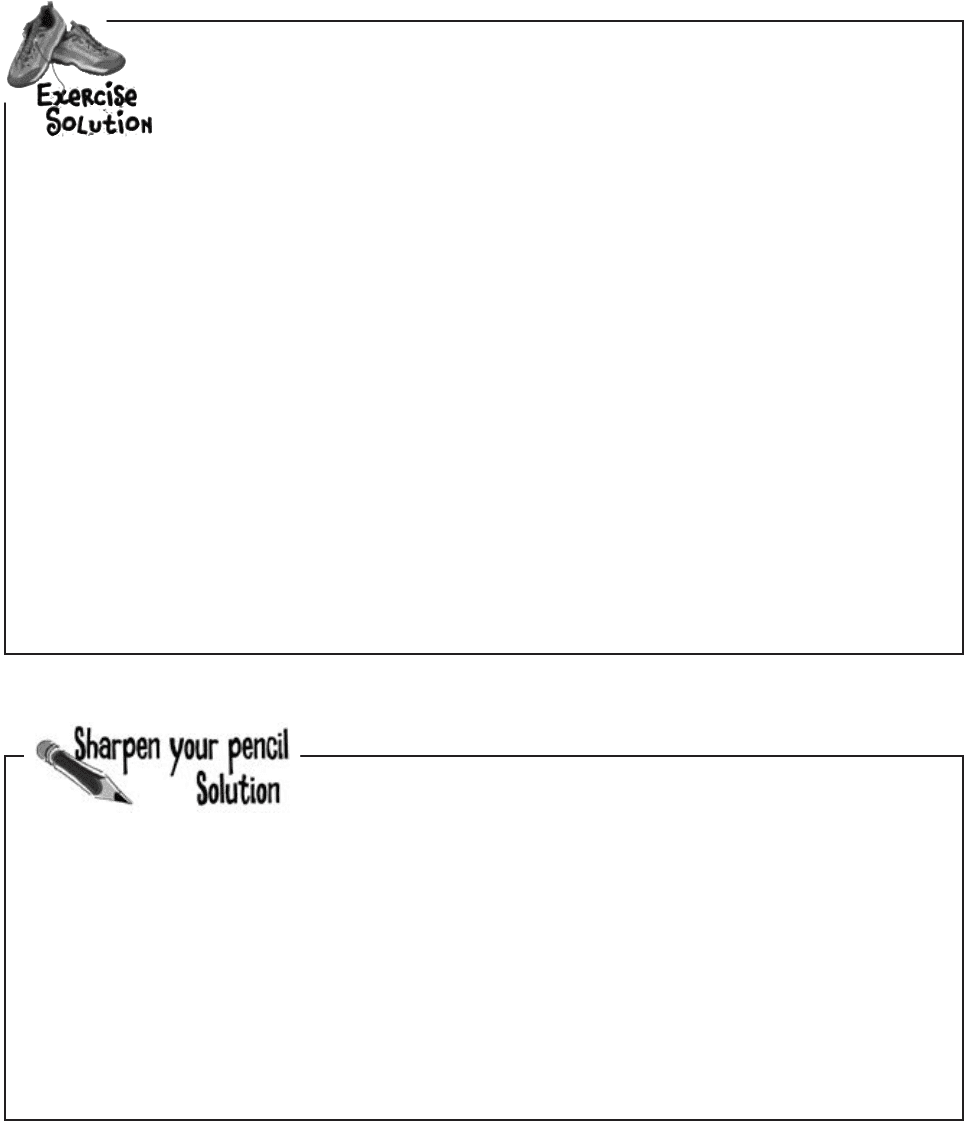
250 Chapter 6
Paula wants to telephone the Statsville Health Club, but she has a very poor memory. She
knows that the telephone number contains the numbers 1,2,3,4,5,6 and 7, but she can’t
remember the order. What’s the probability of getting the right number at random?
Paula has just been reminded that the first three numbers is some arrangement of the numbers
1, 2 and 3, and the last four numbers is some arrangement of the numbers 4, 5, 6, and 7. She
can’t remember the order of each set of numbers though. What’s the probability of getting the
right telephone number now? Hint: This time you need to arrange two groups of numbers.
There are 7 numbers so there are 7! possible arrangements. 7! = 7x6x5x4x3x2x1 = 5040.
The probability of getting the right number is therefore 1/5040 = 0.0002
The probability of getting the right number is therefore 1/144 = 0.0069
The Statsville Derby are organizing a parade for the end of the season.
10 horses are taking part, and they will parade round the race track
in a circle. The exact horse order will be chosen at random, and if you
guess the horse order correctly, you win a prize.
What’s the probability that if you make a guess on the exact horse
order, you’ll win the prize?
10 horses will be parading in a circle, which means there are 9! possible orders for the horses.
9! = 362880, which means there are 362880 possible orders for the parade.
The probability of guessing correctly is 1/9! - which is a number very close to 0.
We start by splitting the numbers into two groups, one for the first three numbers (1, 2, 3),
and another for the last four (4, 5, 6, 7). This gives us
To find the total number of possible arrangements, we multiply together the number of ways
of arranging each group. This gives
Number of ways of arranging 1, 2, 3 is 3! = 3x2x1 = 6
Number of ways of arranging 4, 5, 6, 7 is 4! = 4x3x2x1 = 24
Total number of possible arrangements is 3!x4! = 6x24 = 144
exercise solutions
